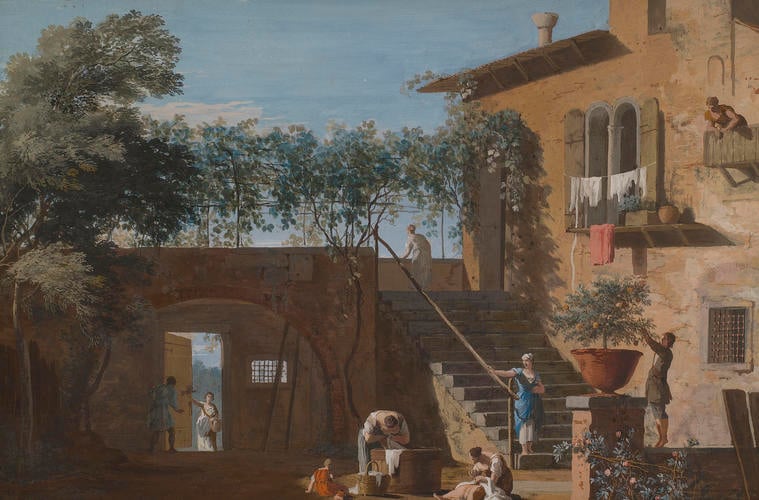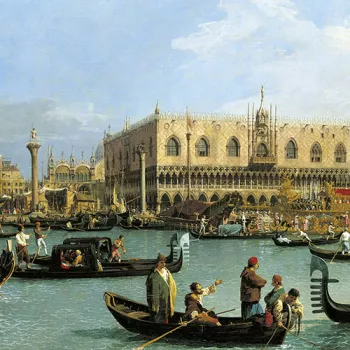The Courtyard of a Country House c. 1728
Gouache on leather | 31.1 x 45.7 cm (support, canvas/panel/stretcher external) | RCIN 406016
-
Marco Ricci produced a large number of paintings of landscape subjects executed in the unusual technique of gouache, or perhaps tempera on leather, possibly kidskin (the paint was made by binding pigments with egg yolk or gum arabic respectively). Typically measuring about 31 × 45 cm, the smooth, pale surface of the skin on the stretcher gives a clarity and luminosity to the bright paint applied to it. Joseph Smith, who knew Marco Ricci well, collected 33 of Ricci's gouache paintings, all but one now in the Royal Collection. All the works are in their original Venetian frames (some have their eighteenth-century glazing intact) and they would have hung in groups, probably on the walls of Smith's residence at Mogliano.
Although most of Marco's gouaches are not dated, they can be placed in the 1720s, his last and most productive decade. Many are pastoral scenes – mountain landscapes, villages and farms – set in the richly fertile and dramatic landscape surrounding Marco's home town of Belluno in the Dolomites. Others illustrate the beauty and power of nature, with dramatic storms, torrents of water in rugged mountains or the surprise appearance of a bear or a snake. These were all subjects that Marco had painted throughout his life, reusing the compositions of existing drawings and oil subjects in the gouache medium. In contrast to his oil paintings, in the temperas the sky is often an optimistic blue, the light refined and subtle.
This painting, a harmonious and charming portrayal of a country house courtyard, is justly regarded as Marco Ricci's most beautiful gouaches. It is a realistic depiction of everyday life in an enclosed world, the walls of the house protecting its inhabitants from the outside world, the trees and pergola protecting them from the heat of the sun. There is also a sense of vigilance within this small community: one woman looks out over the wall from the terrace while another watches the activity in the courtyard from her balcony. People carry out their daily tasks, caring for children, gathering food – one man reaching up on tip-toe to select a lemon – and washing clothes. These larger-scale, more rounded figures are typical of Marco's temperas at the end of the 1720s, and may also show the influence of his uncle Sebastiano's figure style.Text adapted from Canaletto & the Art of Venice, 2017.
Provenance
Acquired from the artist (or after his death) by Joseph Smith, British Consul in Venice; acquired from Smith by George III in 1762 (Italian List nos 116-48); recorded in the Queen's Dressing Room at Kew in 1805 and 1828
-
Medium and techniques
Gouache on leather
Measurements
31.1 x 45.7 cm (support, canvas/panel/stretcher external)
39.6 x 54.6 x 4.0 cm (frame, external)









